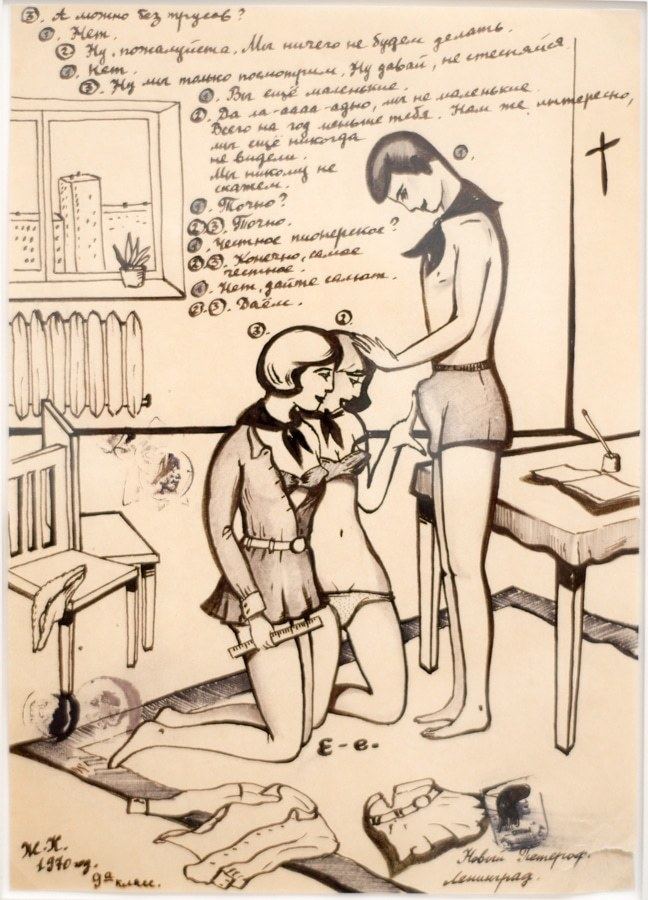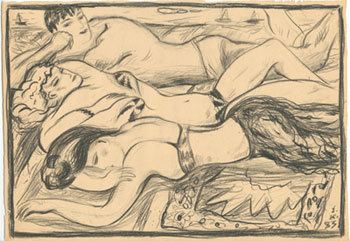Full Name Evgenij Kozlov Movement Chaose Art | Name Evgenij Kozlov | |
 | ||
Born 1955 Leningrad, now St. Petersburg, Russia Education Public high school No. 190 attached to The Saint Petersburg Art and Industry Academy (formerly Vera Mukhina Institute) Known for Painting, drawing, printmaking | ||
Biennale arte 2013 evgenij kozlov
(E-E) Evgenij Kozlov (Russian: (E-E) Евгений Козло́в, tr. (Ye-Ye) Yevgueni Kozlov, IPA: [jɪvˈɡʲenʲɪj) is a Russian artist living in Berlin. Known chiefly as a founder member of the influential art group "New Artists" (Leningrad, 1982—1989), he works under the artist’s name of E-E which has been his sole signature since 2005.
Contents
- Biennale arte 2013 evgenij kozlov
- E E Evgenij Kozlov KINO 1985
- Biography
- Artistic views
- Exhibitions selected
- References
(E-E) Evgenij Kozlov 'KINO' 1985
Biography

In 1978 Kozlov joined the art group "Letopis" and then, in 1982 became one of the first members of the "New Artists", founded by Timur Novikov who, like Kozlov, had also been a member of "Letopis". He was a regular participator in the "New Artists" exhibitions, firstly in Leningrad and then later, at the end of the 1980s, internationally (US, Sweden, England, Finland, Hungary, etc.). He had his first solo exhibition at Timur Novikov’s studio / gallery “ASSA”. The art critic and curator Ekaterina Andreeva points to the influence of his artistic approach on Timur Novikov: “He [Timur Novikov] departed from ‘wildness’ under the influence of Kozlov’s strict style“.

In the 1980s he used to take pictures of his friends and close acquaintances as part of his artistic work. Many of them now represent the second Russian avant-garde in art and music: Georgy Gurianov, Oleg Kotelnikov, Vladislav Mamyshev-Monroe, Timur Novikov, musicians Sergey Kuryokhin, Viktor Tsoi, the ‘New Composers’ Valery Alakhov and Igor Verichev among others. To an extent the camera was for Kozlov the same as a sketchbook for artists of the past in so much as it captured and preserved a moment of inner life for future interpretation.

These pictures, which the author used for paintings, graphic works and collages, are today not only of an intrinsic artistic value, but also, with their coverage of celebrities and events, a rich documentation of artistic life in Leningrad in the 1980s. They have appeared as catalogue covers or in books, magazines and been posters for various exhibitions.
His studio “Russkoee Polee” (“The Russian Field”, 1989–1991) at No. 145 Fontanka River Embankment was a meeting place for artists, curators and gallerists. In 1990 the Austrian performance artist Wolfgang Flatz teamed up with Evgenij Kozlov for a body- painting session.; this was filmed for the public by ZDF, the German TV channel. That same year he saw the Berlin curator Hannelore Fobo visiting his studio whereafter the artist settled in Berlin and later married her.
One of Kozlov’s first exhibitions in Germany was “Der Weg der ockerfarbenen Elefanten“ (“The Path Of The Ocre Elephants“) at Kampnagel, Hamburg, in 1991. It was coproduced with the Centre Culturel, Cherbourg where it was shown the same year as “Le Passage des éléphants ocres“. Kozlov’s works included three large paintings from his series “New Classicism“ (“Новая классика”) which were characterized in an art journal as “self-contained and yet irritating to such a degree that they would hold their own in any exhibition.”
In 1994, with support by the OTIS company, Hannelore Fobo and Evgenij Kozlov opened “RUSSKOEE POLEE 2” in Berlin; the studio, a 400 m2 factory space, ran until 2008. The generous dimensions of his studio allowed the artist to develop large projects, such as “Miniatures In Paradise”, 1995, an exhibition at the Siegessäule (Berlin Victory Column) with motives of angels as well as the cities of St. Petersburg and Berlin. Sixteen “miniatures”, original paintings on fabric in a 5 x 2 m format similar to gonfalons, were hoisted on flagpoles around the Großer Stern on June 15, 1995. The exhibition had to be closed after four of the “miniatures” were stolen. During its fourteen years of existence, “RUSSKOEE POLEE 2” played a prominent role on Berlin's cultural landscape. Not only were there solo exhibitions of which Kozlov was one of the artists but it was also a hub for a variety of concerts and fashion shows. The focus of “RUSSKOEE POLEE 2” was on Russian artists but this was not an exclusive policy. In Berlin Kozlov has continued to enlarge his collection “2x3m” which focuses on works of contemporary Russian artists in this very format.
In 1998 the artist was commissioned by the Abgeordnetenhaus of Berlin (state parliament of Berlin) to create a portrait of Mikhail Gorbachev for its Gallery of Honorary Citizens. In 1999 he was the artistic director of a project dedicated to ten years of the Fall of the Berlin wall. ‘Chocolate Wall’ was organised by the Italian Festival Eurochocolate, Perugia and took place in Potsdamer Platz, Berlin where under Kozlov’s guidance school children painted freely on the chocolate wall. This wall had been built up by Italian pastry chefs; twelve metres long and eight tons in weight it was of course, like its inspiration, also destroyed.
2003 saw the release of his book The Leningrad Album – a selection of 108 erotic drawings from the remaining 256 which had been executed in his youth. A year later the book was given to the curators of the 4th Berlin Biennale Maurizio Cattelan, Massimiliano Gioni and Ali Subotnick, which led them, in 2007, to publish several of the drawings in their book Charley 05, thus including Evgenij Kozlov into the list of 100 “great solitary masters”.
The drawings made a profound impact on Massimiliano Gioni who selected 150 of them for the exhibition “Ostalgia” at the New Museum, New York in 2011 where they were considered to be “a cornerstone of the exhibition”. After having been appointed curator of the 55th Venice Biennale (2013), he decided to make them part of the main exhibition entitled “The Encyclopedic Palace”. The drawings roused intense interest from the public, and the entire stock was sold out in the gallery shop within the first two days.
In 2008 Kozlov began his large cycle “Century XX”, which is a dedication to the last century. To date, the series consists of more than 450 original graphic works and the same number of so-called “light boxes” which are also drawings but carried out on semi transparent paper.
Artistic views
In 2009 Evgenij Kozlov defined a main trend in contemporary art in the 20th century which has now become universal as “Chaose art” and to which he associates part of his own work. A work is considered “Chaose art” if it is generated through assemblage and montage, without a sketch or outline, without a prior meaning; the artist creates and introduces meaning in the process of creation, whilst simultaneously searching for a new harmony. Kozlov sees this tendency best represented by Wassily Kandinsky, Paul Klee, Joan Miró, Jean-Michel Basquiat, Sigmar Polke, Neo Rauch. The term “chaose” is pronounced like “house”, as it combines “chaos” as “meaning before its emergence” with the “e” of “house” as in house music. The letter “e” therefore stands for the rhythm of this art, since "Chaose Art" evokes an inner movement for both the artist and the viewer. This inner movement leads to a perception of depth and freedom and ultimately on to an awareness of knowledge and confidence in chaos.
